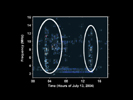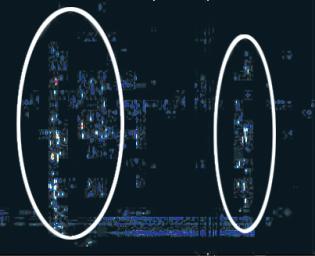
Figure 1The speckles in this graph are radio signals from lightning in Saturn's atmosphere detected by Cassini. Just as one can hear lightning on an AM radio as crackles and pops, Cassini's radio and plasma wave science instrument detects Saturn lightning as bursty signals over a broad frequency range.
This presentation shows the intensity of radio emissions in color as well as their frequency (vertical axis) and time (horizontal axis) on July 13, 2004. Black represents no detectable signal. The lightning emissions appear as short bursts scattered over frequencies from a few megahertz to 16 megahertz. During this time Cassini was 4.9 million kilometers (3.1 million miles) from Saturn. Saturn lightning, like Earth lightning, emits radio emissions over a very broad frequency range. The bursts seen here appear at relatively narrow frequencies. This is because it takes Cassini several seconds to sweep the entire frequency range, but the radio bursts last just a small fraction of a second. So, Cassini detects the bursts at whatever frequency it happens to be at in its sweep when a burst occurs.
During the 18-hour interval represented in this display, Cassini detected two general intervals of lightning signals separated by 10 or 11 hours. During this time, Saturn rotated around its axis once -- one Saturn day. So, these signals appear to be coming from the same storm system in the atmosphere which lasted for at least a Saturn day. However, the appearance of the radio emissions is quite different after one day, indicating the storm system is evolving on this time scale.
The Cassini-Huygens mission is a cooperative project of NASA, the European Space Agency and the Italian Space Agency. The Jet Propulsion Laboratory, a division of the California Institute of Technology in Pasadena, manages the Cassini-Huygens mission for NASA's Science Mission Directorate, Washington, D.C. The Cassini orbiter was designed, developed and assembled at JPL. The radio and plasma wave science team is based at the University of Iowa, Iowa City.
For more information about the Cassini-Huygens mission, visit http://saturn.jpl.nasa.gov and the instrument team's home page, http://www-pw.physics.uiowa.edu/plasma-wave/cassini/home.html.

 Planetary Data System
Planetary Data System













